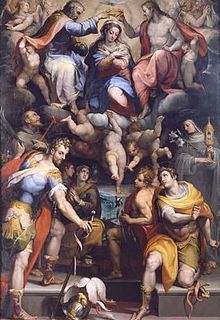Related Research Articles

Pope Alexander I was the sixth Bishop of Rome from c. 107 to his death c. 115. The Holy See's Annuario Pontificio (2012) identifies him as a Roman who reigned from 108 or 109 to 116 or 119. Some believe he suffered martyrdom under the Roman Emperor Trajan or Hadrian.
Pope Telesphorus was the eighth bishop of Rome from c. 126 to his death c. 137, during the reigns of Roman Emperors Hadrian and Antoninus Pius. He was of Greek ancestry and born in Terranova da Sibari, Calabria, Italy. The Carmelites venerate Telesphorus as a patron saint of the order since some sources depict him as a hermit living on Mount Carmel. He is also a martyr according to the ancient testimony of Irenaeus.

March 22 - Eastern Orthodox liturgical calendar - March 24

March 26 – Eastern Orthodox liturgical calendar – March 28

April 17 - Eastern Orthodox liturgical calendar - April 19

April 28 - Eastern Orthodox liturgical calendar - April 30

Saint Apollonius the Apologist or Saint Apollonius of Rome was a 2nd-century Christian martyr and apologist who was martyred in 185 under the Emperor Commodus (161-192).
A martyrology is a catalogue or list of martyrs and other saints and beati arranged in the calendar order of their anniversaries or feasts. Local martyrologies record exclusively the custom of a particular Church. Local lists were enriched by names borrowed from neighbouring churches. Consolidation occurred, by the combination of several local martyrologies, with or without borrowings from literary sources.

Nabor and Felix were Christian martyrs thought to have been killed during the Great Persecution under the Roman emperor Diocletian. A tomb in Milan is believed to contain their relics.
Saint Gabinus is the title given to two personages.

Symphorosa is venerated as a saint of the Catholic Church. According to tradition, she was martyred with her seven sons at Tibur toward the end of the reign of the Roman Emperor Hadrian.

November 22 - Eastern Orthodox liturgical calendar - November 24
Saint Lydia may refer to:

Saints Florus and Laurus are venerated as Christian martyrs of the 2nd century. According to a Greek tale, they were twin brothers who worked as stonemasons. They were originally from Constantinople, Byzantium but settled in Ulpiana, Dardania, south of Pristina, Kosovo in the district of Illyricum. They were educated in the art of masonry by two men named Maximus and Proculus, who were Christians.
Philetus may refer to:
Januarius and Pelagia were joint Christian martyrs and saints recorded in the Jerusalem Martyrology. They were beheaded or racked and torn with iron claws and pieces of earthware at Nicopolis in Armenia during the reign of the Roman emperor Licinius. Their feast day observed on July 11. They are possibly to be considered identical with SS Januarius and Marinus who were martyred in the same place in the same year under identical circumstances with the martyrs Nabor and Felix; their feast day, however, was observed on July 10. Alternatively, the quartet may have been a combination of Januarius and Pelagia with the SS Nabor and Felix were martyred in Italy in the early 4th century.
Edward Burden (c.1540–1588) was a sixteenth century recusant priest. Born in County Durham, he was a graduate of Corpus Christi College, Oxford. He studied at Duoay College and was ordained a priest in Rheims in 1584. He is probably best known for being one of the Eighty-five martyrs of England and Wales, for, arriving in England in 1586, he was captured two years later and executed by hanging, drawing and quartering in York on 29 November 1588,
Alexander Crow was born in Yorkshire around 1550. He took up an early trade as a shoemaker, and hearing of an opportunity to follow his trade at the English College, then at Rheims, he travelled to France. He worked as a cobbler, porter, then under-cook at the seminary. Eventually he trained as a priest and was ordained in Laon in 1583.
George Douglas was one of the Eighty-five martyrs of England and Wales.
William Lampley was a sixteenth-century English recusant. A glover by trade, he was described as being 'little of education, yet with an almost apostolic zeal in religion.' Apparently betrayed by one whom he had recently aided, he was convicted of assisting priests. He was executed in Gloucester on 1 August 1588.
References
- ↑ Our Sunday Visitor's Encyclopedia of Saints p502 Matthew Bunson, Stephen Bunson - 1998 "Phanurius (date unknown) + Martyr, called a warrior- saint. From Crete, he ... with companions. Philetus was supposedly a senator who resided in the province of Illyria and was put to death during the persecution under Emperor Hadrian (r.
- ↑ Saint of the Day, March 27